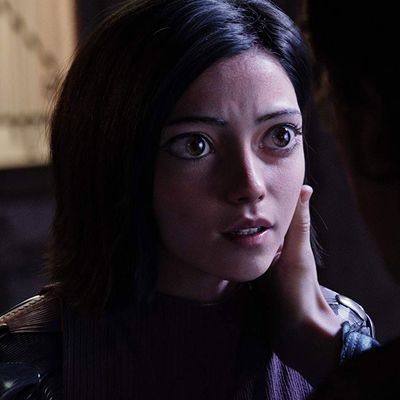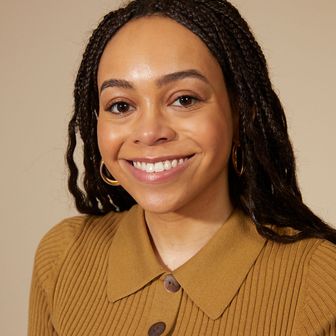
True to the manga it’s based on, the titular protagonist of Alita: Battle Angel has eyes bigger than the average human’s. They’re light brown and catch the light, highlighting their amber specs. They’re wet and emotive, and look nearly human, except that they’re each about the size of a mandarin orange. It’s a jarring image that takes a little getting used to, but eventually you adjust; Alita’s eyes look more supersized than otherworldly. They’re not flat and passive like the visual effects eyeballs of years past. They look hopeful, scared, confused, alert. They look like eyes.
“It’s really easy to fall into the uncanny valley,” said Eric Saindon, an FX supervisor at Weta Digital who worked on the eyes for Alita, in theaters next February, and previously on The Lord of the Rings, Pete’s Dragon, and Avatar. “We had to go back and forth with the size of the eyes, and the separation of the eyes, to come up with something that was natural, but still gave the feeling of the manga.”
Eyes are among the hardest visual effect to perfect. Best-case scenario, they look something like Caesar’s in the Planet of the Apes trilogy: vivid, emotional, alive. Worst-case, they look like The Polar Express: passive, doll-like, dead. In the near-decade since Alita producer Jon Landau produced Avatar with James Cameron, the technology that goes into creating CG eyes that reflect actors’ performances has improved immeasurably. At the time, for example, capturing Andy Serkis’s performance and morphing him into Gollum was considered a groundbreaking innovation. But “it was quite simple geometry,” Saindon said. For Alita, the geometry is far more detailed across every layer of the eye. “With Gollum we introduced multiple layers into the eyes to allow us to displace and get new layers of depth,” he said. “With Alita, we have moved further by replacing the textures with actual geometry for the depth and shadowing.”
Alita’s eyes are a breakthrough, Landau says, because of how the effects reflect and enhance Rosa Salazar’s performance. While Salazar stars as the cyborg Alita, her co-stars are all played by real, live humans, including Mahershala Ali and Christoph Waltz, setting the bar for realistic-looking eyes even higher. “We actually had to [scan in] Salazar’s eyes,” Saindon said. “You always could feel the emotion through the eyes, because it’s Rosa’s emotion on the CG character.”
CGI eyes used to be purely computer generated, but now, VFX designers can manipulate an actors’ eyes to create the ones we see onscreen. Weta’s designers use their own patented process to scan human eyes. (The process is similar to a technique pioneered by Disney, which allows for the capture of eyes in greater detail. In 2016, a team of researchers used a database of images of eyes to mimic the “perfect imperfections” of the human eye’s design, using facial scanning for eye reconstruction.) The Weta simulation creates geometry for each layer of the eye, then breaks up the eye’s fibers and stretches them, in a process similar to what happens when eyes age. Gollum’s eyes used 50,000 digital polygons. Alita’s, by contrast, have 9 million polygons in just one iris — the rendering is exponentially more precise.
Once they drafted how Alita’s eyes should look, Fox producers worked with Weta Digital on “a series of iterative processes where we tried smaller irises, bigger pupils, less sclera, all these different things,” Landau said. “We could only do so much in the concept art form. We went through a number of things where we were getting shots back and seeing her come to life.” Alita’s two eyes went through approximately 50 variations over several months, during which the designers made a series of tiny adjustments: to the corners of the eyes, the outsides of the eyes where the eyelashes come together — arranging each individual eyelash — and to how the eyes’ movements were reflected on the character’s forehead and in her body movements.
Not every such production incorporates an actual actor, which is why we still end up with eyes like Wesley Snipes’s flat, cloudy CGI eyes in Blade. (Flat eyes that don’t sparkle with life are easier to produce and copy across characters.) But when they do, it increases the vividness of the final image. “What’s best,” Saindon says, “is always to have an actor perform the eyes. To get the subtleties of the detail from an actor, it will always be the key. If you really watch the movement of someone’s eyes, they’re always weeping, they’re always fluttering, they’re always darting back and forth a little bit. They always have that little bit of extra motion that you don’t even notice.” (When designing animal eyes — or animal-like eyes, as he did on Pete’s Dragon — Saindon says you can get away with “realistic-looking” eyes without quite the same level of attention to detail.)
The next challenge was mastering how light is reflected in the eyes. “The caustics always change the lighting as it goes through the fibers,” Saindon said. “It’s a really hard math problem to get right.” Even harder are the tears, and Weta is working to streamline how they’re created and incorporated. “The amount of wetness in the eyes, the connection between that emotion and wetness when you’re changing emotion, is something we [haven’t succeeded in piecing together]. We have to do it very manually right now,” Saindon said.
Landau recently screened scenes from Alita for an audience and was impressed by their reaction. “They don’t question that she’s physically there, interacting with Christoph Waltz, kissing Keean Johnson, looking with rage at Mahershala Ali,” he said. “That’s a testament to where Weta was able to take the eyes and the whole performance.”


